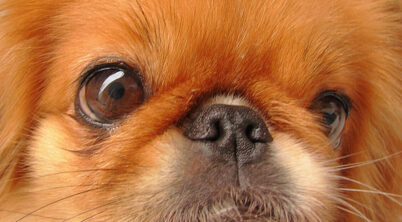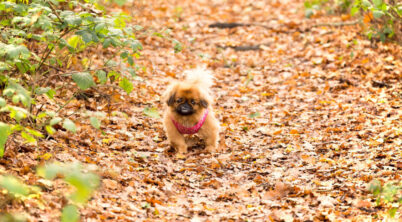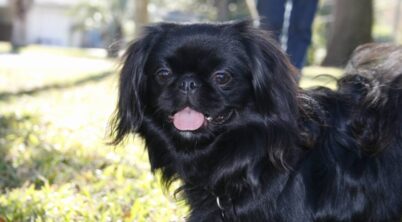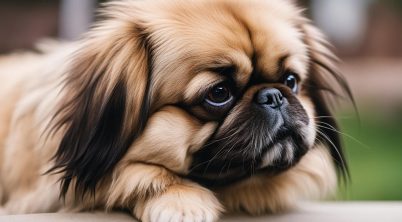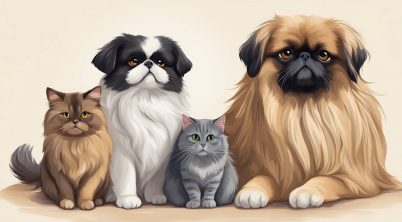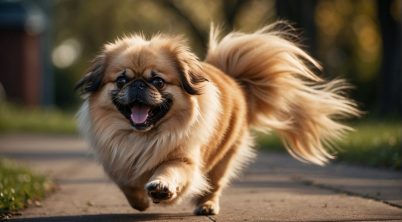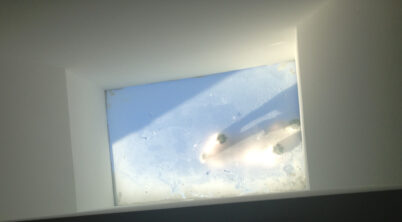The Pekingese, a breed with ancient origins from China, carries a distinct and esteemed lineage. Its history is deeply rooted in the Chinese Imperial Court where it was once revered as a lap dog for nobility, symbolizing wealth and status. With its compact size and characteristic lion-like mane, the Pekingese presents a unique canvas for creative grooming. The breed’s double-layered coat, which is thicker around the neck and shoulders, provides an ideal foundation for various haircuts, including the stylish ‘Pekingese Mohawk’.
Grooming styles like the Mohawk are a modern twist on the traditional appearance of the Pekingese. While this breed’s grooming usually aims to maintain its natural, lion-esque look, the Mohawk haircut is a playful deviation that caters to pet owners looking for a more unconventional style. It involves trimming the dog’s hair into a strip that runs along the back while the rest of the fur is cut shorter, which emphasizes the Pekingese’s regal bearing in a contemporary manner.
Adopting such hairstyles requires consideration of the Pekingese’s grooming needs, which include regular brushing to prevent matting, as well as attention to overall well-being. While haircuts like the Mohawk may not be historically representative of the breed’s storied past in China, they certainly showcase the versatility of the Pekingese’s luxurious coat and the breed’s ability to meld ancient dignity with modern pet fashion trends.
Table of Contents
Pekingese Mohawk
Pekingese dogs have distinctive coats that can be styled in various ways. One unique hairstyle that stands out among Pekingese owners is the “Mohawk.” This style accentuates the dog’s natural mane by trimming the hair on the sides and leaving a strip of longer hair on top of the head and down the spine.
Styling a Pekingese Mohawk
- Preparation: Begin with a clean, well-groomed Pekingese. Mats and tangles should be removed.
- Trimming: Carefully trim the hair on the sides of the body to a uniform length, ensuring that the top strip is clearly defined.
- Maintenance: To maintain the Mohawk, regular grooming sessions are needed to keep the sides tidy and the top strip prominent.
Benefits of the Mohawk:
- Visibility: It keeps the dog cooler in warm weather by removing excess hair.
- Cleanliness: Less hair on the sides can mean a cleaner Pekingese, as there is less fur to catch dirt and debris.
- Style: It provides a striking and unique appearance that can be eye-catching at dog events.
Owners should note that this is not a traditional style for the breed and may not be suitable for show dogs where breed standards for coat are strict. Those interested in the Mohawk should consult with a professional groomer who has experience with creative dog grooming and the Pekingese breed in particular.
Physical Characteristics
The Pekingese is a breed notable for its distinctive physical features that reflect its regal ancestry. These dogs present an air of elegance combined with a unique structure, setting them apart from other toy breeds.
Appearance
The Pekingese possesses a well-proportioned and compact body marked by a bold and lion-like appearance. The breed exhibits a regal bearing and is characterized by a flat-faced profile, large eyes, and a short snout. Their overall appearance conveys self-importance and sometimes an aloof demeanor.
Size and Weight
- Height: Typically, they stand about 6-9 inches tall at the shoulder.
- Weight: A healthy Pekingese weighs from 6 to 14 pounds, with standards set by the American Kennel Club disqualifying any Pekingese over 14 pounds in conformation shows.
Coat Colors and Texture
The Pekingese sports a double coat that is long and coarse on top with a thick, softer undercoat. This breed’s mane is more pronounced around the neck and shoulders, adding to the “lion dog” moniker. The coat colors can include:
- Red
- Tan
- Gold
- White
- Black
- Black and tan
- Cream
- Sable
- Gray
The texture and array of colors contribute to their eye-catching appearance. An interesting note is the Pekingese’s coat is longest on the back of thighs, tail and toes.
Grooming Needs
Pekingese dogs possess a luxurious coat that requires diligent grooming to maintain its health and appearance. Regular maintenance is key in preventing mats and ensuring the comfort of these small yet regal canines.
Brushing and Trimming
Frequent brushing is necessary to prevent mats and tangles in a Pekingese’s long, flowing coat. A minimum of a few times a week is recommended, using a quality brush to gently work through the fur. Trimming is also important, particularly around the eyes, ears, and paws to avoid discomfort and maintain visibility for the dog. Tools commonly used include sharp scissors and clippers, which help to neatly trim the coat and preserve the Pekingese’s distinctive lion-like appearance.
Bathing Requirements
Bathing a Pekingese should be done with care, using a dog-formulated shampoo. It’s imperative to rinse the dog thoroughly, as residue can cause skin irritation. A regular bathing schedule aids in keeping the coat clean but should not be overdone to avoid drying out the skin.
Eye and Dental Care
The Pekingese breed is prone to eye issues due to their prominent eyes. Owners must pay special attention to the area around the eyes during grooming, cleaning any discharge and trimming the fur to prevent irritation. Similarly, dental care is a part of grooming maintenance, necessitating regular teeth brushing to safeguard against dental diseases.
Behavioral Traits
The Pekingese breed exhibits distinct behavioral traits that are essential to understand for proper training and social interaction. Their temperament can be quite regal, reflecting their background as a favored pet in Chinese royalty. Their interactions with family, children, and strangers also possess unique characteristics that require a tailored approach, especially in training, where their intelligence and stubbornness come into play.
Temperament
The Pekingese is often described as having a lion-like temperament; they carry themselves with dignity and a certain self-importance. This breed may show an independent streak that can be perceived as aloofness. Yet, they can also display moments of high affection towards their owners. Their royal ancestry can be a source of both proud personality traits and distinct challenges.
Social Behavior
In terms of social behavior, the Pekingese can be wary of strangers and may express this through barking or a reticent demeanor. However, they tend to be devoted to their family. These dogs might not always be the ideal choice for households with small children due to their somewhat delicate nature and preference for a calm environment.
Training Challenges
Training a Pekingese may present certain hurdles attributable to their intelligence coupled with stubbornness. Utilizing positive reinforcement techniques is crucial as they respond better to rewards rather than harsh corrections. It is also important to maintain consistency to overcome the breed’s inherent independent nature. When implementing training programs, one must be patient and persistent to successfully navigate the challenges posed by a Pekingese’s temperament.
Pekingese in Popular Culture
The Pekingese breed has made its mark on popular culture, notably for their connection to royalty and a storied imperial past. Queen Victoria famously owned a Pekingese named Looty, gifted to her after the Second Opium War, symbolizing the breed’s entrance into Western high society. The small, lion-like dog was not only a pet but also a living treasure from the East, reflecting a history of luxury and exclusivity.
These dogs often appeared alongside prominent figures, reinforcing their status as regal companions. In artwork, Pekingese were frequently depicted with lavishly attired nobles, and this trend continued into contemporary times with celebrities often photographed with their Pekingese pets.
Beyond personal companions, Pekingese dogs have had historical significance. The Pekingese named Chang was a notable example, sharing the spotlight with the world-famous Hagenbeck Zoo’s marmoset monkeys. Chang’s presence underscored the breed’s charm and the exotic appeal that Europeans found in Asian flora and fauna.
The Pekingese’s unique appearance, compared to the mythical Chinese lion, coupled with their ancient lineage, has maintained their allure in modern-day culture. While they are not as ubiquitous as other breeds in media, their dignified expressiveness and storied history continue to fascinate enthusiasts and historians alike. Their impact on popular culture remains evident, symbolizing a blend of cultural mystique and aristocratic elegance.

